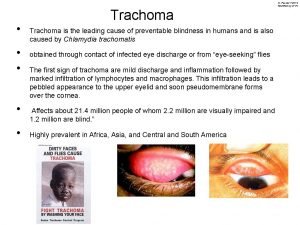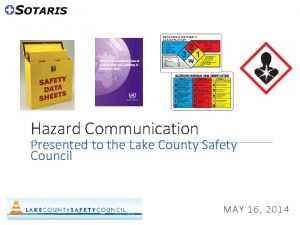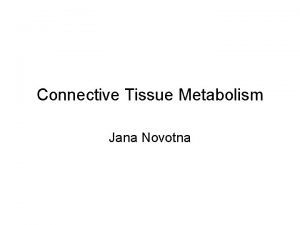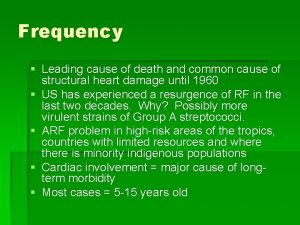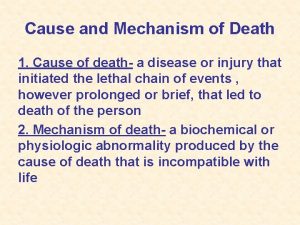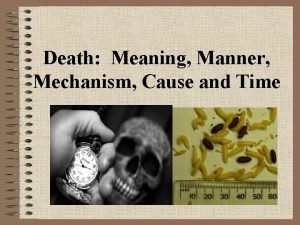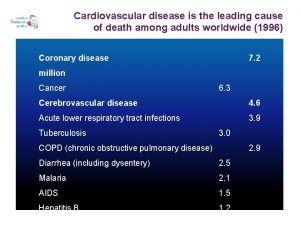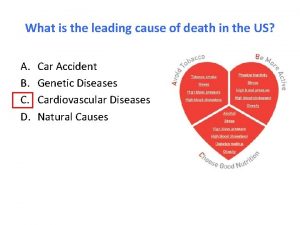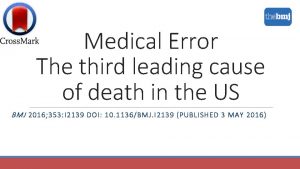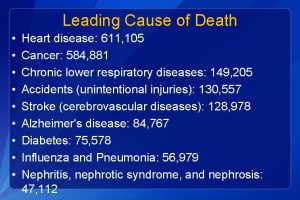2 nd overall leading cause of cancer death























- Slides: 23


2 nd overall leading cause of cancer death in the United States › 3 rd in each sex Approximately 6% of individuals in the US will develop a cancer of the colon or rectum within their lifetime 944, 717 incident cases worldwide in 2000

Incidence rates for colorectal cancer differ by sub-sites

Vast majority of colorectal cancers are adenocarcinomas, which are preceded by adenomas or adenomatous polyps in most cases Only around 10% of adenomas will develop into cancers, a process that takes at least 10 years

147, 500 colorectal cancer cases in 2003 › 105, 500 colon › 42, 00 rectum 57, 100 deaths from colorectal cancer Slight decreases in mortality rates since 1973 in both sexes



Overall 5 year survival rate is 61. 9% › Differs by race, age, and distribution of disease Survival rates are lower among than blacks than whites › 52. 8% vs. 62. 6% Survival rates are highest for localized cancers

Incidence rates start to increase after age 35 with a rapid increase after age 50, when more than 90% of colorectal cancers develop

Overall age-standardized incidence rates were 65. 1 per 100, 000 for men and 47. 6 per 100, 000 for women › Male-female ratio=1. 37 Mortality rates were also higher in men than women › 25. 4 versus 18. 0 per 100, 000

Race and Ethnicity › Higher rates and mortalities among blacks than whites Socioeconomic status › Possible association between low SES and colorectal cancer mortality

Fruit, Vegetables, and Fiber › Majority of case-control studies have shown an association between higher intake of vegetables and lower cancer risk › Recent large cohort studies have shown weak or non-existent association between fiber and colon cancer risk Folate › Higher intake of folate has been relatively consistently associated with lower colon cancer risk

Calcium › Avoidance of low intakes of calcium may minimize risk of colon cancer Fat, Carbohydrates, and Proteins › Excess energy intake leading to obesity increases the risk of colon cancer › Possible association of red meat with increased risk

Higher BMI is associated with an increased risk of colon cancer › Approximately twofold higher risk in individuals who are overweight or obese

Individuals who are more physically active have a decreased risk of colon cancer Some benefits appear to be independent of BMI › Studies have shown dose-response relationship between physical activity and colorectal cancer › Highest risk observed in persons who are both physically inactive and have high BMIs

Alcohol › Somewhat controversial, but appears that high alcohol intake increases risk Tobacco › Most studies indicate excess risk in smokers

Familial Adenomatous Polyposis (FAP) › Rare, inherited, autosomal dominant syndrome › Causes occurrence of multiple colorectal adenomas in individuals in their 20 s and 30 s that untreated, will lead to cancer Hereditary Nonpolyposis Colorectal Cancer (HNPCC) › Autosomal dominant inherited disorder

Family history of colorectal cancer History of adenomatous polyps Several low-penetrance genes Type 2 Diabetes Growth factors › High insulin-like growth factors › Hyperinsulinemia

Inflammatory Bowel Disease Gallstones and Cholecystectomy Glucose Intolerance, Non-Insulin Dependen Diabetes Mellitus Acromegaly

Prevention of smoking Prevention of weight gain Maintenance of a reasonable level of physical activity in adulthood Limit red and processed meats, high-fat dairy products, highly refined grains and starches, and sugars

Early detection and removal of colorectal adenomas reduces risk of cancer Screening is recommended for adults beginning at age 50 › Fecal occult blood test (FOBT) annually › Sigmoidoscopy every 5 years Or › Colonoscopy every 10 years For high risk individuals, screening should be tailored to their expected risk

Research on modifiable hormonal pathways associated with greater risk Role of micronutrients such as calcium and folate and other agents Identification of genetic susceptibility

Cancer Epidemiology, 3 rd ed. 2006. Oxford University Press Centers for Disease Control American Cancer Society
 A carefully developed overall approach to leading
A carefully developed overall approach to leading Objectives of roving frame
Objectives of roving frame Leading cause of preventable blindness
Leading cause of preventable blindness Leading above the line
Leading above the line May cause cancer pictogram
May cause cancer pictogram Will you fight now or wait for this
Will you fight now or wait for this Proximate and ultimate behavior examples
Proximate and ultimate behavior examples Difference between innate and learned behavior
Difference between innate and learned behavior Ter death certificate
Ter death certificate Ultimate cause of behavior
Ultimate cause of behavior Eldridge moores cause of death
Eldridge moores cause of death Cause of death
Cause of death Brock franklin
Brock franklin Johannes vermeer catharina bolnes
Johannes vermeer catharina bolnes Edward fudge cause of death
Edward fudge cause of death Masako natsume cause of death
Masako natsume cause of death Yana novotna cause of death
Yana novotna cause of death Dena schlosser case
Dena schlosser case Antonio vivaldi cause of death
Antonio vivaldi cause of death Algor mortis chart
Algor mortis chart What was humpty dumpty's cause of death geometry
What was humpty dumpty's cause of death geometry Chrisomes death
Chrisomes death Daily iodine requirement
Daily iodine requirement Portia white timeline
Portia white timeline


